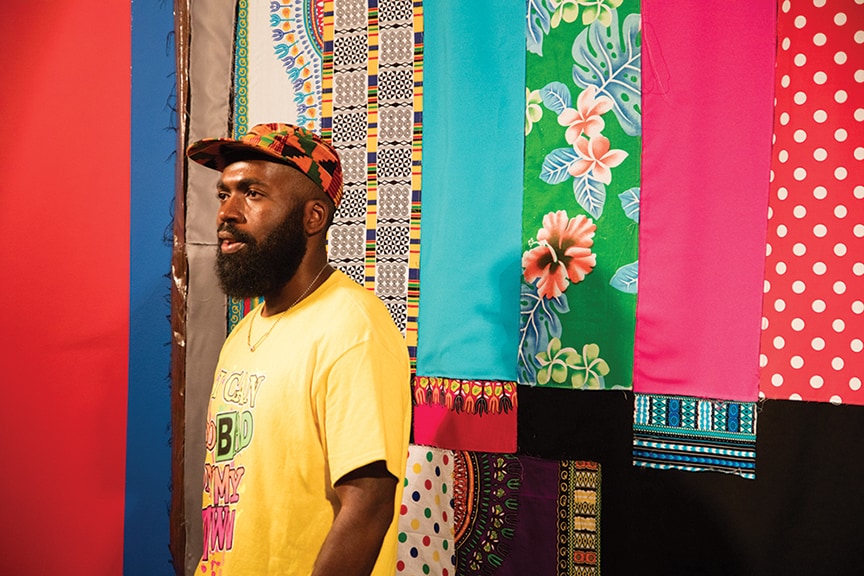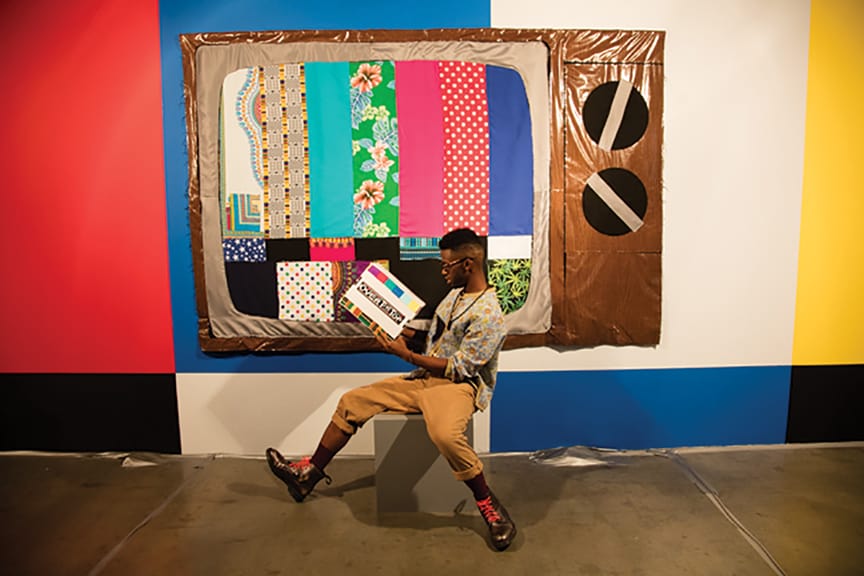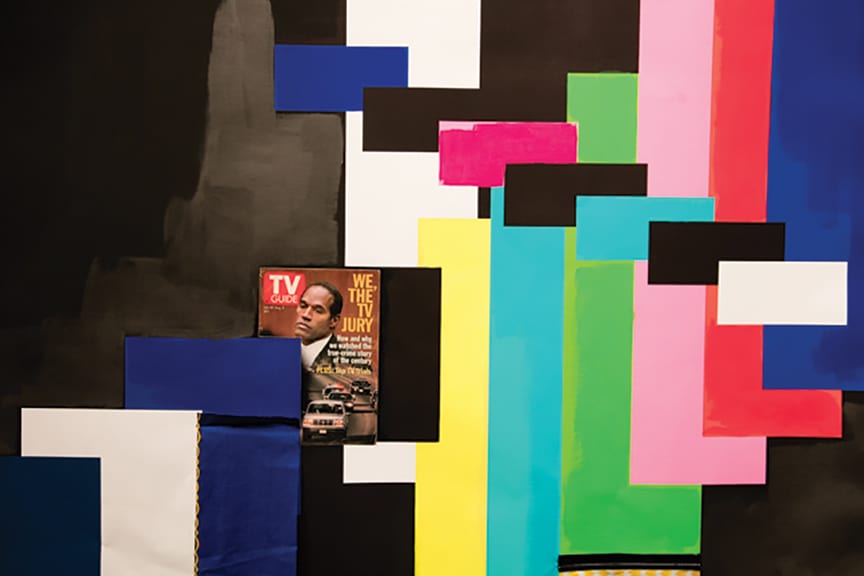For anyone interested in changing the media landscape of American culture, Derrick Adams is an artist at the forefront of that dialogue. His latest exhibition, ON, is currently on view at Pioneer Works, Red Hook’s ownleading contemporary art venue. The exhibition offers a layered critique of consumerism, capitalism, race, gender and personal autonomy through the lens of television, entertainment and pop culture.

What appears at first glance to be a deluge of color, playful sculpting and a feel good visual landscape is in many ways a metaphor for the subliminal messaging embedded in the cultures of television and advertising.
Adams’ literal construction of large-scale televisions are made of cloth, mixed media collage or wood, with bold vibrant color panels and textiles as screens. This creates an undeniable framing of over the top content. This artistic strategy – and its subtle use of the absurd – creates a critical distance for viewers to take a closer look at ephemera interspersed throughout the work: retro TV Guides, African textiles, and images of legendary infomercial psychic, Cleo.
Upon closer inspection it becomes clear that Adams is focused on African American television iconography from the late 20th century. His repeated use of the SMPTE color bar image, (a standard television test pattern), could also be read as a reflection of the absence of openly LGBTQ bodies in that period’s media landscape.
A consistent use of juxtaposition throughout the installation of the work is neatly sectioned off in separate galleries throughout Pioneer Works’ minimalist warehouse.
In one room, nine lamp sculptures of heads on organically-crafted, wood bases sport a variety of African hair braiding designs that function as lampshades. Perhaps, a commentary on – or a metaphor for – enlightened minds reclaiming headspace.
These sculptures are presented in conversation with two-dimensional collages hanging on the surrounding walls. The collages echo the SMTPE color bar motif and include TV Guide covers that feature top black sitcoms and stars from the 80s and 90s – Oprah Winfrey, Bill Cosby, Gary Coleman, Dihann Carroll, Sanford and Son, and OJ Simpson among others.
These TV personalities on view – in relation to what is known of their current lives – offers a poignant visceral reaction to the dangers and possibilities of a life in popular culture.
The placement of these two bodies of work – the lampshades and collages – in a shared space poses questions about the social construction of identity. What is black? Who is defining what black life is? What is the relationship between Africa and America? Who is doing the storytelling? Television?
Adjacent to this room, this same interplay of external/internal identity politics takes on a spiritual dimension. The far wall of this space is dimly lit with a colorful variety of yoga mats laying on the floor, and houses a finely crafted television made of wood. The detailing is reminiscent of Japanese shoji screens. The television screen hosts small three-dimensional illuminated candle like objects. The theatrical face of Cleo, the late-night television psychic mainstay, peers back through night lights as if lit from within with divine presence.
In this installation, the fine line between mysticism and spiritual delusion is in full effect. The benefits, commercialization, and popularity of yoga are also brought up for critical inspection, once again exploring where mass media and authentic self-actualization intersect.
A grander, less intimate experience occupies Pioneer Works’ largest gallery space. Nine extremely large televisions crafted from a variety of media hang as wall sculptures and a backdrop for opening night performances. The televisions include variations of the color bar sequence that are made distinct by the intentional placement of fabrics that speak in a lighthearted vernacular to the African American experience.
West African dashiki fabrics echo Adams’ choice of collage as a formal technique, while more comic choices like materials patterned with hot wings or marijuana leaves lend a sense of humor to the work.
The opening night performance was orchestrated by Adams’ and featured a large group of performers hawking faux infomercial products in front of each of the nine televisions. Accompanied by a loud mix of sales chatter pumping through a Big Brother style sound system, the cacophony of noise felt like a soliloquy of chaos.
Video of the performance exists as documentation and will be projected onto a gallery wall for the tenure of the exhibition.
For those who attended opening night, the foyer of Pioneer Works was also activated with a one-time only Derrick Adams happening: a party. DJ Swizz Beatz ignited the space with throwback tunes apropos to the exhibitions themes.
Adams a community builder
Fans who have followed Adams’ work over many years and incarnations – as a gallery director, DJ and artist – know of his love of community building. Creating inviting atmospheres of joy is central to his practice. They symbolize what appears to be an ongoing interest in a humanitarian ethos, the evolution of culture and the liberation of not only the black mind, but also the American mind.
Based in New York, Adams’ background includes work as a multidisciplinary artist working in performance, video, sound and 2D and 3D realms. Adams is originally from Baltimore. He received his MFA from Columbia University, BFA from Pratt Institute, and is a Skowhegan and Marie Walsh Sharpe alum. His exhibition and performance work has been featured at MoMA, PS 1, Brooklyn Museum of Art, PERFORMA, Studio Museum in Harlem, and the Brooklyn Academy of Music.
The exhibition, ON, is a culmination of an ongoing series of work by Adams called Live and In Color that also explored ideas on televisuality. His presentation of the work at Pioneer Works is a unique opportunity to see his vision in a vast space open to experimentation. The exhibit is truly stimulating to the mind and eye. A deeper read of ON offers insight into the manufacturing of identity and perhaps how agency can be carved and sculpted when one simply takes a step back, questions, laughs and keeps it moving.
ON is on view at Pioneer Works through July 17, 2016 from 12-6 pm Wednesdays through Sundays at 159 Pioneer Street and is free and open to the public. For more information, visit www.pioneerworks.com.
Author
Discover more from Red Hook Star-Revue
Subscribe to get the latest posts sent to your email.









